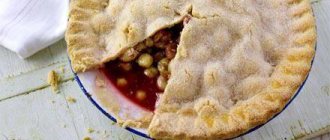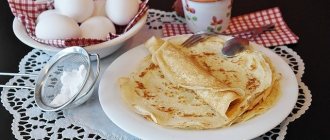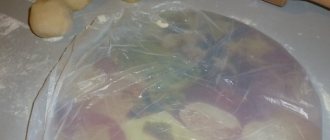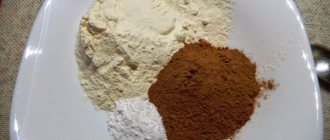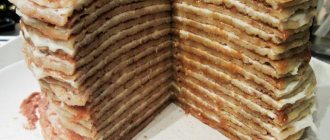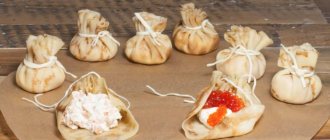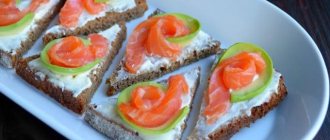Additional Information
Well, who doesn't love cottage cheese donuts? It may not be the healthiest dessert, but sometimes you can treat yourself. By the way, this recipe is very simple and my favorite.
14 July 2020, 12:59
Cooking time: 45 min.
Number of servings: 6
Nastya’s new book has everything for the coziest New Year - recipes for miracles that become possible only during New Year’s time, when the family gathers under one roof. One has only to make a wish and contribute a little to its fulfillment, and a whole house will appear in your home kitchen, almost a real one - gingerbread!
Access to this page has been denied because we believe you are using automation tools to view the website.
This may happen as a result of:
- Javascript is disabled or blocked by an extension (such as ad blockers)
- Your browser does not support cookies
Make sure Javascript and cookies are enabled in your browser and you are not blocking them from loading.
Link ID: #3fb45a00-2e10-11ea-a29f-2f9b0c48fa8a
Many of us simply adore custard rings with curd cream from childhood, and I am no exception to the rule =). I tried several recipes for filling the rings: with curd mass from the store, and with sugar, and with white chocolate - everything is delicious, but “it all tastes wrong.” The ideal curd cream turned out to be the one I’ll talk about in this recipe. In fact, it is very easy to prepare and its secret is that the cottage cheese is mixed with butter cream, this is the only way to obtain a homogeneous, smooth, very tasty and tender filling for the custard rings.
How to prepare choux pastry for cakes (step-by-step recipe with photos):
If you have ever prepared profiteroles, eclairs, or choux pastries according to my recipes, then you will be able to cope with the rings without difficulty, because any choux pastry from the above recipes is suitable for their preparation.
Place butter (100 g) in a thick-bottomed saucepan, pour in water (180 g), add salt (1/3 tsp), put on fire and melt. The heat should be medium so that everything melts and heats up as quickly as possible.
Constantly stir the contents of the saucepan so that the mixture melts and boils faster.
Before boiling, the heat can be high or medium, but after boiling it should be reduced to low.
Wait for the mixture to boil and immediately pour in all the flour (200 g).
Stir until the lumps disappear, so that there is no white flour visible anywhere. We make intense movements, trying to smooth the dough along the walls and bottom of the saucepan. At first it will be successful, but as it brews the dough will form a lump.
The dough will be properly brewed if it has stood on the fire for 2 minutes after gluing into a ball, and a film has appeared at the bottom of the saucepan. In the photo below you can see that there is a crust on the bottom. It should not be peeled off (otherwise it will be felt as hard lumps in the finished cakes); the very fact of such a layer at the bottom indicates that everything is going according to plan. Set the choux pastry aside and move on to the eggs.
Custard ring with curd filling
Elegant and very appetizing custard rings will look worthy at a tea party for any company.
When preparing the products, we would like to immediately clarify: for the filling we used sweet curd paste, since it is very convenient to put such a mass into the reservoir of a pastry syringe and place it on the blank ring. It is quite possible to use regular store-bought cottage cheese in the recipe, you just need to combine it with the desired portion of sugar and mix thoroughly until the mass is even, and you can put it on the rings with a teaspoon.
Products
- water – ½ cup;
- flour – 80 g;
- egg (category C 0) – 2 pcs.;
- salt – 1/tsp;
- butter – 50 g;
- powdered sugar – 1 tsp;
- sweet curd mass – 200 g.
Recipe
1. Pour the specified amount of water into the saucepan. Immediately add the butter, chopping it into pieces. On medium heat, bring the liquid to a boil and add salt.
2. Reduce the fire intensity of the stove to the very minimum value. Add all the flour to the boiling oil mixture, while actively stirring the contents of the pan with a spoon.
3. After some time of our constant efforts, the mass will easily move away from the walls of the saucepan, and then turn off the heat.
4. Cool the dough slightly in the saucepan. Let's beat in the first egg. Continue to work intensively with the spoon, stirring the egg into the custard mixture.
5. After achieving uniform consistency at the previous stage, add the second egg and repeat all previous steps, that is, actively mix it into the dough.
6. We should end up with a homogeneous, fairly viscous mass, which, when deposited on a baking sheet, is capable of holding the shape specified by the nozzle.
7. Line a standard baking sheet with high-quality cooking parchment. Fill the container of a pastry syringe with viscous dough. Let's install the toothed attachment. Pipe the dough in the form of rings onto the paper.
8. Pre-heat the oven. Baking time will vary from 45 minutes to an hour. The temperature regime in this case is not constant: for the first 15 minutes the temperature should be high (about 200 degrees), then it should be reduced to 160°C. The finished custard rings are airy with voluminous gaps inside.
9. Cut each ring crosswise with a sharp knife blade. We will place the curd filling on the base, which we filled the syringe with in advance (the nozzle is still the same). Place the second part of the custard ring carefully on top of the curd mass.
10. Using a fine strainer, lightly dust each cake with powdered sugar. You can start tasting the custard rings with delicious curd filling.
Bon appetit!
receptino.ru
Popular recipes
- Pollock stewed in tomato sauce
- Marinating rabbit and hare meat
- Chicken fillet baked with vegetables and cheese
- Goose baked in the sleeve
- Blue whiting baked in the oven
New recipes
- Buckwheat with fish and mushrooms
- Beef and zucchini cutlets
- Chicken wings in tomato-mayonnaise sauce (in the oven)
- Muffins with minced chicken and sausage cheese
- Smelt stuffed with mozzarella (in the oven)
Preparing curd cream for cakes
In the simplest recipe, the cream is made from butter and powdered sugar, but if you add condensed milk, the cream will turn out even tastier. It is the whipped butter cream that is responsible for the tenderness and uniformity of the filling; in addition, the curd cream ceases to be cloyingly sweet.
Many people replace powdered sugar with regular sugar. It should be remembered that sugar cannot dissolve in oil. If you make such a replacement, you will feel it in the cream and crunch on your teeth. It is for this reason that either powder is added to the cream, or sugar syrup is boiled with milk and eggs (as in Charlotte cream). For curd cream, you need to choose pasty curd. If you use a granular one, it will be very difficult to bring it to a homogeneous state. Initially, you need to beat softened butter (175 g) with powdered sugar (90 g) until white.
How to make curd rings:
1. I made small deviations from the recipe, but they are not in GOST: I used milk and water in equal proportions, although according to the recipe, milk is not needed; and added a teaspoon of granulated sugar. This is not necessary, especially if you want traditional rings.
Heat water, salt and butter over medium heat. Butter will give a more natural taste than spread or margarine, so don't try to substitute it.
2. The butter has melted, and now you need to prepare the required amount of wheat flour, which we immediately add to the main ingredients and mix very actively until a dense and stable dough is formed. At this stage, the stove can already be turned off.
3. This photo is not here by chance: look at the velvety crust that covers the bottom of the pan: if it has already formed, then the dough is ready and can be set aside to cool slightly.
4. Why do we cool the dough? We still have chicken eggs left, and if we throw them in right now, they will simply boil, due to the magical properties of the protein and the tendency to coagulate. This choux pastry will not rise and will lie flat in the oven. But as soon as the dough has cooled, we add eggs to it, one at a time and mix thoroughly until smooth.
5. Place the dough into a cornet and squeeze it directly onto a baking sheet, in the form of rings (I did not oil the foil and the rings came away from it perfectly, but for your own peace of mind, you can use a small amount of vegetable oil to lubricate the surface). At a temperature of 220 degrees, the custard rings are baked for 15 minutes.
6. The finished ones brown perfectly and do not fall off after removing them from the oven (but if you are still afraid of this, turn off the device and let them stand inside for a few more minutes).
7. Prepare the cream: mix all the ingredients and it is better to do this using a mixer.
8. Cut the ring in half, put the filling straight along and inside. At first it may seem that when you close the filling with the “lid” of the ring, the cream will simply spread to the sides. But don’t be afraid, if you keep these curd rings in the refrigerator for a few minutes, the filling will soak into the rings and remain inside, with no chance of escape.
Bon appetit!!!
Best regards, Yulia.
Custard ring with curd cream
Simple and delicious! Try it!
For the recipe you will need: (for 12 – 14 rings)
For the test:
125 g water 125 g milk 125 g butter 150 g flour 5 g salt 10 g sugar 4 – 5 large chicken eggs
For cream:
100 g butter 150 – 200 g sugar 400 g soft cottage cheese Bag of vanilla sugar (if desired) Powdered sugar for sprinkling the rings
PREPARATION:
First, a little history of choux pastry:
“It is believed that choux pastry was invented in 1540 by Panterelli, the cook of Catherine de Medici, and called his work pate a Panterelli. Over the years, the original recipe was modified, and with it the name: the dough began to be called pate a Popelini, later - pate a Popelin. Usually, “swaddles” were shaped into the shape of a woman’s breast – at least that’s what it seemed to the ardent Italians. Around 1760, the French pastry chef Jean Avis (by the way, the teacher of the founder of the St. Petersburg school of cooking, Marie-Antoine Carême) created choux buns. True, something similar existed in French cuisine back in the middle of the 18th century, but only similar, nothing more. This is how pate a choux was prepared at that time: “Boil the potatoes, mash them. Add the eggs and use a spoon to form into cabbage-like balls. Bake." The brilliant Jean Avis, undoubtedly familiar with the ideas of his predecessors (it is not without reason that they say that French cuisine was largely created by Florentine chefs), simply replaced the potatoes with brewed flour and got unusual buns. Why exactly buns? The fact is that Jean, about whom Karême wrote: “the famous Avis, master of choux pastry,” at that time worked as the chief pastry chef in the best pastry shop in Paris on rue Vivienne and supplied his masterpieces to the table of the great French diplomat Talleyrand. Subsequently, Karem himself had a hand in improving his teacher’s choux pastry, which began to be called exactly the same - pate a choux, that is, “dough for cabbage heads.” Poor Pantherelli and French mashed potatoes are gone. And the dough “shu” - “for cabbage heads” - on the contrary, went down in history.” Wikipedia and nnm.ru/blogs/serein/pirozhnoe_shu
And now a little theory.
The driving force behind choux pastry is water vapor. Yes, yes, it is because of this that it rises so much during baking and it is thanks to water vapor that a void is formed inside the cakes, which can be filled with filling or cream. In this regard, for a good rise, the choux pastry must, firstly, contain a large amount of water, and, secondly, it must be elastic enough to retain these vapors during the baking process. But first things first.
A high level of hydration of choux pastry is achieved in two ways: by pre-cooking the flour, as well as by introducing a large number of raw eggs, which contain a lot of liquid, into the dough. A few words about brewing: brewing flour consists of two stages - at the first stage, the flour is poured into hot water, as a result of which the starch included in the flour gelatinizes and in such a gelatinized state it is able to hold much more water, which significantly increases the level of hydration dough, and at the second stage the dough is slightly dried, the liquid that remains unbound is evaporated.
So, by brewing and introducing raw eggs into the dough, the dough with a high level of hydration is kneaded, but this is not enough, because if the dough does not have sufficient elasticity, it will simply crack during baking and all the steam will escape without fulfilling its main purpose. In order for the dough to be elastic, firstly, it is very important to use flour with “strong” gluten or, at a minimum, not to use flour with “weak” gluten, and secondly, pay special attention to the consistency of the dough so that it is not too liquid, not too thick and, thirdly, choose the right baking mode (taking into account the characteristics of your oven).
And now the recipe itself.
For the choux pastry, heat water in a saucepan, add milk, chopped butter, salt, and sugar. While stirring, ensure that the butter is completely dissolved and the salt and sugar are completely dissolved. Immediately after the boil begins, remove the pan from the heat and in one fell swoop add all the flour required for the recipe (pre-sifted).
Rub the mixture intensively with a spatula or spoon until it reaches a uniform consistency (without flour lumps).
Return the saucepan to medium heat and, while vigorously rubbing and turning, heat the dough for another 1 - 2 minutes until it comes together into a single lump and “begins to give off flour,” i.e. until a white flour coating appears on the bottom of the pan.
Place the brewed dough in a bowl and grind for another 2-3 minutes until the dough cools slightly and is no longer scalding hot (about 60 C).
Gradually fold in the eggs into the chilled dough, one at a time.
Mix in the eggs gradually, each subsequent one only after the previous one has been completely mixed in. If it is difficult to stir in a whole egg, you can first scramble the egg with a fork and stir in it in parts. Be sure to check the consistency of the dough before adding another egg. Ideally, it should slowly flow from the spatula in a triangle or, as they say, form a “bird's tongue”.
Place the finished dough into a pastry bag with a notched or round tip (diameter about 10 mm) and place on a baking sheet lined with baking paper or lightly greased with vegetable oil or butter (when greasing with butter, be sure to dust with flour). Place the rings at a distance of at least 4 - 5 cm from each other, since the dough greatly increases in volume during baking and sticking may form if deposited close together.
The baking mode for choux pastry depends very much on the characteristics of your oven. Traditionally, baking begins in an oven preheated to 210 - 220 C so that a light crust forms on the dough, preventing the escape of water vapor, after 10 minutes the temperature is reduced to 180 - 190 C and already at this temperature they bake until golden brown and completely cooked (about another 25 minutes).
It is very important not to open the oven door for the first 20 minutes, as this may cause the dough to settle, and it’s just as important! bake the dough well, as unbaked bases may settle and will also be moist inside. When baking, remember the golden rule that it is better to overbake choux pastry than to underbake it, so if you are in doubt whether it is ready or not, then it is better to decide that it is not ready and bake until there is no doubt.
In addition to the traditional one, there are other baking modes: you can bake the bases at a constant temperature of 180 - 190 C; you can preheat the oven to 250 - 260 C, after planting the dough, turn off the oven completely, and after 10 - 15 minutes set it to 170 C and bake at this temperature until done; or preheat the oven to 200 C, after 10 minutes set it to 170 C, and after another 10 minutes reduce the temperature to 160 C and bake until fully cooked.
Only practice will show which mode will work in your oven; I prefer the most traditional one, i.e. first option.
Immediately after baking, poke holes in the bases to allow any remaining steam to escape. I usually pierce with a tube that I will use to fill the rings. Punctures can be made from below or from the side.
Transfer the baked rings to a wire rack and let cool completely.
For the cream, beat the butter and sugar. If desired, add a packet of vanilla sugar or a few drops of vanilla essence for flavor.
Stir in the cottage cheese and the cream is ready.
Transfer the cream into a pastry bag fitted with a long narrow tip.
Fill the rings with cream.
A little powdered sugar on top and enjoy your tea!
Ring with curd cream GOST
A favorite custard ring by many. People often complain that curd cream at home does not turn out as it should. In fact, everything is very simple and, most importantly, very typical for catering establishments. For these rings, cottage cheese is mixed... with butter cream. In half. In the simplest version, the cream is made from butter and powdered sugar, but the cream with the addition of condensed milk has a more pleasant taste. It is with the whipped buttercream that the filling turns out tender, not cloying and just right. And I won’t fail to say a few words about sugar and powdered sugar. Remember that sugar does not dissolve in oil. And if you add sugar instead of powder to the cream, it will crunch unpleasantly on your teeth. That is why powder is either added to the cream or syrup is made from sugar (with milk and/or eggs). This also applies to vanilla sugar, if you use it - you need to grind it in a mortar before adding it to the cream. Choux pastry is made according to this recipe; traditionally, the rings are pressed through a toothed attachment, then powdered sugar falls on them very beautifully. The diameter of the nozzle is 10-15 mm.
Ingredients for 15 pieces
200 g flour 100 g butter 180 g water pinch of salt 2 g 300 g eggs (5 large)
320 g cottage cheese 17 5 g butter 90 g powdered sugar 65 g condensed milk 1 bag of vanilla sugar 1 tbsp. cognac or dessert wine
Powdered sugar for sprinkling
Preparation:
So, for the dough, put 100 g of butter in a saucepan, pour in 180 g of water, add a pinch of salt. Bring to a boil.
Add sifted flour (200g) and mix well.
The flour should be cooked and the dough should stick together into a ball. Attention! The flour should be well brewed; for this, do not immediately remove from the heat, but stir directly on the stove.
Transfer it to a bowl to cool to at least 60C.
Scramble the eggs in a bowl.
Add a little at a time, kneading the dough with a mixer or spatula.
Ready dough.
Transfer to a bag with a notched tip, 10-15mm in diameter, and place the rings on a baking tray lined with baking paper.
Bake at 220C for 15 minutes, then at 180C for 25 minutes. Cool.
Prepare the cream.
Beat softened butter with powdered sugar and ground vanilla sugar until white. Add condensed milk in several portions, whisking thoroughly at maximum speed. At the end add cognac.
Rub the cottage cheese through a sieve into the finished cream.
Cut the rings and fill them with cream. You can do it from a bag, you can just use a spoon.
Sprinkle with powder.
But before eating, cool thoroughly!
Recipe for custard ring with curd cream
Delicate curd sweetness combined with airy dough: what could be more perfect for a nutritious breakfast or a treat at a family tea party?
Ingredients:
For the test
Water - 125 g milk - 125 g butter - 125 g wheat flour - 150 g egg - 5 pcs. sugar - 10 g salt - 5 g
For cream
Butter - 100 g cottage cheese - 400 g sugar - 150 g powdered sugar
Cooking method:
1. To prepare the dough, heat water in a saucepan, pour in milk, butter, add salt and sugar. Cook, stirring constantly, until the butter is completely melted and the salt and sugar are dissolved. As soon as the mixture boils, remove the pan from the heat and add the sifted flour.
2. Using a silicone spatula, stir the dough until smooth. Return the pan to the stove and continue heating over medium heat and stirring with a spatula until the dough begins to come together into a single mass.
3.Place the dough into a bowl and rub until it cools slightly.
4. Mix chicken eggs into the warm dough one by one. The dough should become elastic and flow slowly from the spatula. If the dough does not flow, stir in another egg.
5. Set the oven to preheat to 200 degrees. Transfer the dough into a pastry bag with a notched tip and place the rings on a baking sheet (spaced apart, as they will increase in size) lined with parchment paper. To prevent the paper from slipping, drop a few drops of water on the baking sheet and only then lay the paper down.
6.Bake the rings at 200-220 degrees for about 10 minutes, then reduce the temperature to 180 degrees and cook for another 20-30 minutes. The door cannot be opened during the baking process, and if the rings are not finished baking, they may then settle.
7. We transfer the finished rings to a wire rack and make punctures in them to allow steam to escape; later we will fill them with cream through the same punctures.
8.Prepare the cream. Beat butter at room temperature with sugar and cottage cheese. It is best to use soft, homogeneous cottage cheese.
9.Place the cream in a pastry bag with a long tip and fill the cooled rings with it. Before serving, sprinkle them with powdered sugar (it’s more convenient to do this through a sieve). Bon appetit!
Ring with curd cream
A real GOST custard ring. It's done quickly enough and eaten even faster.
Dough: about 15 pieces
Water - 180 g Butter - 100 g Flour - 200 g Egg (large) - 5 pcs or 300 g Salt pinch
Preparation:
Bring water, salt and oil to a boil. Immediately add flour, mix quickly and thoroughly without removing from the stove. The flour should brew well and there should be no white lumps left. Stir the dough on the stove until it begins to lag behind the walls of the dish and gathers into a lump. Allow to cool to a temperature of 60*C (so that the eggs do not overcook). Gradually adding eggs, knead the dough with a mixer, spatula or just a whisk. Place the finished dough on parchment in the form of rings. Bake at T=220*C for the first 10 minutes, then at T=180* until done (about 25 minutes). Cool.
Cream:
Butter - 150 g Cottage cheese - 200 g Powdered sugar - 90 g Condensed milk - 65 g Vanillin/vanilla sugar
Preparation:
Beat butter with powder and vanilla until fluffy. Continuing to beat, add condensed milk. Rub the cottage cheese through a sieve (if there are lumps), put it in the butter cream and beat again. Cut the rings lengthwise and fill with cream. Sprinkle powdered sugar on top.
It is not at all necessary to make rings; you can plant round shu. The original had a little more butter and less cottage cheese. I've rounded it up. It is better to cool the finished cakes first, then sprinkle with powder, because... The cream melts quickly due to the large amount of butter.
Custard cakes “Curd Ring”
Custard cakes with delicate curd cream. Favorite cakes from our childhood.
Products
For the choux pastry:
125 ml water 125 ml milk 100 g butter margarine or butter 150 g flour 4 eggs pinch of salt
For the curd cream:
300 g cottage cheese 50 g butter 120 g sugar 1 bag of vanilla sugar powdered sugar for decoration
How to prepare custard cakes “Curd Ring”:
1. Prepare the choux pastry. Bring margarine (or butter), milk, water and salt to a boil over low heat until the margarine is completely dissolved.
2. Add the sifted flour and mix thoroughly. Knead the dough over the heat for at least two minutes. The dough should stick together into a ball and leave the sides of the pan well behind.
3. Remove from heat and let the dough cool slightly (up to 60 degrees). Add eggs one at a time while kneading the dough.
4. Place the thoroughly kneaded dough into a pastry sleeve (pastry bag, syringe) with a toothed nozzle, and squeeze rings (15 pieces) onto a baking sheet covered with parchment.
5. Place the dough in an oven preheated to 210 degrees and bake the cakes for 10-15 minutes. Then reduce the temperature to 180 degrees and bake until done for another 15-20 minutes. Prick the finished custard cakes with a toothpick to let the air out. Cool.
6. Prepare curd cream for custard cakes. Cream butter with sugar and vanilla sugar.
7. Rub the cottage cheese through a sieve and add to the oil. Beat the cream until smooth.
8. Cut the cooled cakes and fill with cream. Sprinkle the curd rings with powdered sugar.
Custard cakes “Curd Ring” are ready. Bon appetit!
Custard rings with curd cream
Ingredients 6 servings
Wheat flour 200 g Chicken egg 3 pieces Water 180 g Salt pinch Cottage cheese 320 g Butter 175 g Condensed milk 65 g Vanilla sugar to taste Cognac 1 tablespoon Powdered sugar 1 tablespoon
Instructions
1. To prepare the choux pastry, pour water into a saucepan, add butter and salt. Put it on fire. When the mixture boils and the butter has completely melted, add the sifted flour at once. Stir thoroughly and quickly, without removing from heat, until all the flour is well cooked. Place the finished dough in a bowl to cool to 60–70 degrees (or lower).
2. Meanwhile, scramble the eggs in a separate bowl. Add eggs to the dough little by little, stirring each time until smooth. The finished dough has a homogeneous structure, a viscous consistency, and falls off the spoon if you hit it on the edge of the bowl.
3. Transfer the dough to a piping bag fitted with a scalloped tip (diameter 10-15mm) and pipe 15 rings (average diameter 65mm) onto the baking tray. Bake for 15 minutes at 210 degrees, then 25-30 minutes at 180 degrees. Refrigerate.
4. For the cream, beat the butter with powdered sugar and vanilla sugar until fluffy and light in color, add condensed milk little by little, beating well. At the end of whipping, add cognac. Rub the cottage cheese through a sieve and add to the cream. Mix thoroughly.
5. Cut the rings and fill with cream. Sprinkle with powdered sugar and cool well.
A favorite custard ring by many. People often complain that curd cream at home does not turn out as it should. I came across recipes with condensed milk, sugar, and store-bought curd mass. Tasty, but not that good. In fact, everything is very simple and, most importantly, very typical for catering establishments. For these rings, cottage cheese is mixed... with butter cream. In half. In the simplest version, the cream is made from butter and powdered sugar, but the cream with the addition of condensed milk has a more pleasant taste. It is with the whipped buttercream that the filling turns out tender, not cloying and just right. And I won’t fail to say a few words about sugar and powdered sugar. Remember that sugar does not dissolve in oil. And if you add sugar instead of powder to the cream, it will crunch unpleasantly on your teeth. That is why powder is either added to the cream or syrup is made from sugar (with milk and/or eggs). This also applies to vanilla sugar, if you use it - you need to grind it in a mortar before adding it to the cream. The choux pastry is made according to, traditionally the rings are pressed through a toothed attachment, then the powdered sugar falls on them very beautifully. The diameter of the nozzle is 10-15mm.
15 pieces Dough: 200g flour 100g butter 180g water a pinch of salt 2g 300g eggs (5 large pieces)
Cream: 320 g cottage cheese 175 g butter 90 g powdered sugar 65 g condensed milk 1 bag of vanilla sugar 1 tbsp. cognac or dessert wine
powdered sugar for sprinkling
Prepare the dough as directed. Transfer to a bag with a notched tip, 10-15mm in diameter, and place the rings on a baking tray lined with baking paper.
Bake at 220C for 15 minutes, then at 180C for 25 minutes. Cool.
Prepare the cream. Beat softened butter with powdered sugar and ground vanilla sugar until white. Add condensed milk in several portions, whisking thoroughly at maximum speed. At the end add cognac.
Rub the cottage cheese through a sieve into the finished cream.
Cut the rings and fill them with cream. You can do it from a bag, you can just use a spoon.
Sprinkle with powder.
But before eating, cool thoroughly!
Delicious, soft, airy curd donut rings are very easy to prepare and are perfect for breakfast with a cup of aromatic tea or coffee. You can serve with powdered sugar, jam, preserves, condensed milk, honey, sour cream.
Fill the custard rings with cream
After the custard rings have cooled, cut each into two halves. The porous structure inside indicates that the dough was cooked correctly.
Transfer the cream into a pastry bag (you don’t need to use a metal tip here), squeeze the filling into each ring in a circle and cover with the second part of the ring.
These are the custard rings with curd cream you get. Enjoy your tea!
When adding a photo to Instagram, please indicate the tag #pirogeevo or #pirogeevo so that I can find your photos on the Internet and rejoice with you. Thank you!
